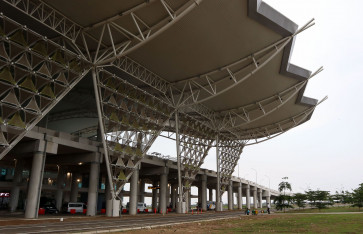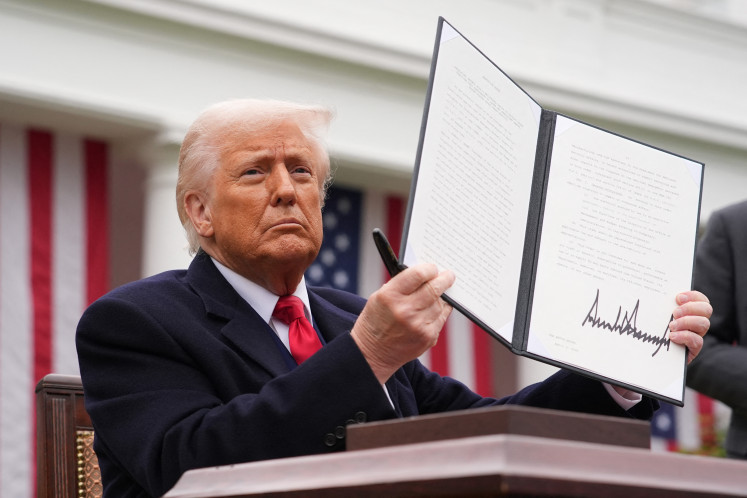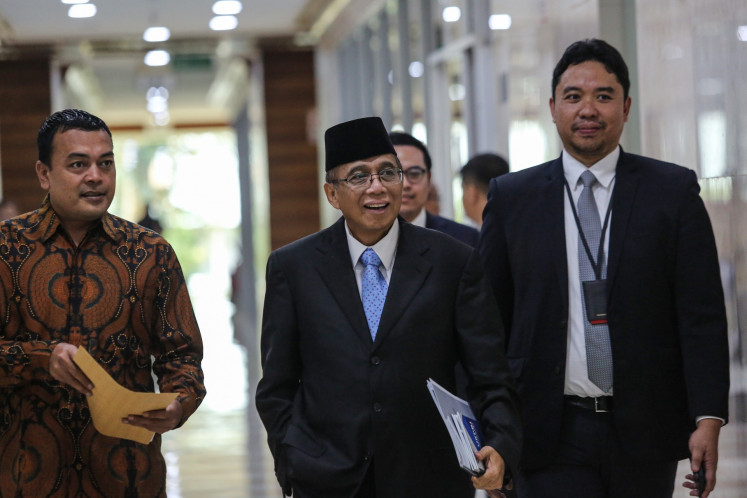Popular Reads
Top Results
Can't find what you're looking for?
View all search resultsPopular Reads
Top Results
Can't find what you're looking for?
View all search resultsDiscourse: Still a bumpy ride ahead to economic recovery, BI governor says
Agus Martowardojo - JP/Jerry AdigunaThe ride to domestic economic recovery is predicted to remain bumpy and challenging in 2016 as global risks loom on the horizon
Change text size
Gift Premium Articles
to Anyone
Agus Martowardojo - JP/Jerry Adiguna
The ride to domestic economic recovery is predicted to remain bumpy and challenging in 2016 as global risks loom on the horizon. Bank Indonesia (BI) Governor Agus Martowardojo talked to The Jakarta Post regarding next year's outlook and BI's own policy stance. Here are edited excerpts of the interview.
Question: The economy has been quite subdued in 2015, with layoffs in the real sector and a volatile rupiah affecting the confidence of people and business. What can BI do to help stoke growth? Can we afford to lower interest rates at this time?
Answer: I see it differently. To me, it's quite a relief that Indonesia could post economic growth of
4.73 percent in the third quarter from 4.67 percent in the second and 4.7 percent in the first. We know that the growth rate averaged around 6 percent in the past 10 years and it has been declining in the last three years, but the growth climbed higher in the third quarter.
Hopefully this is a turning point. It seems that the economic growth can be maintained in the future, but we really must balance between pursuing economic growth and keeping macroeconomic and financial system stability.
We may think that, 'Our trade balance is already positive, the inflation rate has declined and our current account deficit has narrowed,' but they haven't shown a really stable condition to allow us [the central bank] to change our tight monetary stance.
Right now the source of uncertainty and volatility is in developing countries, of which Indonesia is a part. Many of these countries are suffering from economic contraction. China grew at an average rate of 10 percent from 2000 to 2011, but recently China said that it aimed for 6.5 percent economic growth over the next five years.
So if China is slowing down, we must be cautious because we are closely connected to China. Its slowdown even poses a bigger threat than the US with its rate normalization plan.
Meanwhile, Brazil has recently been stripped off its investment-grade rating [from major ratings agency Standard & Poor's]. That can have an impact on other countries and trigger people to say, 'Invest in developing countries? We'll just wait until they hit bottom, only then we will invest.' These kinds of things worry us.
What about the Fed?
The US has shown improvements, but it hasn't increased its rate up until now and people are nervous about it, while at the same time, people are getting ready to see funds return to the US.
They think that it's best to invest in a currency with a strengthening trend and high interest rate. The US dollar fits the profile because they know that the US will gradually jack up its interest rate. So, there will a rebalancing in the liquidity. Funds will flee, looking for other promising destinations.
This has somewhat created a concern over Indonesia's financial portfolio with the private sector's rising offshore loans, but I can assure you that the current situation is totally different from the situation in 1998-1999. The amount of offshore loans is still within a safe level.
The other risk facing Indonesia is falling commodity prices that have pushed our exports down. We used to have a significant contribution from the manufacturing sector to exports, but we were so swayed by the high commodity prices that we underwent a deindustrialization process and just exported raw commodities.
Now commodity prices have fallen. Our imports are higher than exports and we see a gap in the current account. When such a thing happens, it's impossible to have a strong currency. How can you have a strong rupiah when you need a higher amount of dollars than what's available in the market?
All of these have provided us with a lesson on how to take a monetary stance domestically. That's why we chose to put stability over growth back in 2013 when the US announced its tapering plan. We knew we'd be impacted. We raised our rate and allowed the rupiah to weaken. In the end, we survived 2013.
Are you saying you're maintaining the 'stability over growth' stance?
We are maintaining our stance. Apparently the crisis that emerged in 2008 has not ended. In 2015, the US has said that it is looking to normalize its rate, to increase it. This is another worrying period.
But here, there are people that insist, 'Lower the rate, 7.5 percent is already too high because inflation is falling.' Wait, [year-on-year] inflation rate has indeed reached 6.25 percent, but risks remain.
We must be cautious. We must consider the mid-term outlook if we want to change our stance and we have to recognize that there is still external volatility.
If we are careless in setting the interest rate, for example, the exchange rate of the rupiah will immediately plummet. Today the rupiah depreciated only because of the sentiment from the US' nonfarm payroll data. If we are not careful, we will be in trouble. This is difficult to explain to the public.
So BI will still prioritize non-interest rate tools to help boost growth?
Yes. We will continue to [preference non-interest rate tools] because, like I already said, we still face many threats.
BI has three authorities: monetary, macroprudential and payment system. In the macroprudential area, I can act. If banks' financing for small and medium enterprises (SMEs) is done in a good and healthy way, we can give incentives so that their minimum reserve requirement (GWM) can be lower. Hence, they [banks] can be more expansive. What we previously tightened, such as motorcycle and apartment ownership loans, we loosen a little bit so lending can grow.
The loan growth of banks is already at 10.9 percent. We hope it can be better and help economic growth.
What makes you optimistic about 2016?
The government has continuously rolled out new economic policy packages every two weeks and infrastructure projects seem to be advancing. We are optimistic. We believe that next year's economic growth will be between 5.2 and 5.6 percent.










